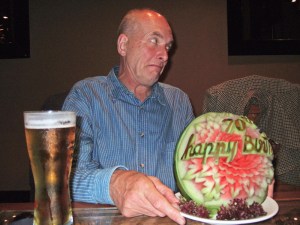Updated 09/07/24
On 27th May 2024 Bolton, and the nation as a whole, lost one of it’s legendary sons.
Born on 9th September 1950 Richard ‘Rick’ Parker became interested in conservation after watching a pond being destroyed by a bulldozer when he was a child. After studying at University he went on to work for the Bolton Hospital’s pathology lab to make a living, but his real passion was wildlife and in the 1980’s he joined the fledgling Bolton Conservation Volunteers, becoming the group’s co-ordinator/chairman in 1985/1986, a role he held until his passing. For anyone to lead a volunteer group for 38 years is an outstanding achievement, but to do it with the same commitment and passion throughout that time is extraordinary, and is what made Rick such a legendary figure.
Rick took BCV to new heights of success creating hundreds of ponds, establishing reed beds, and planting tens of thousands of trees throughout his leadership. Along the way both Rick and BCV won multiple awards, Bolton Councils Golden Elephant Award, Certificate of Merit from Britain in Bloom, Bolton News Green Hero Award (twice), The Cabinet Office’s Points of Light Award, to name a few. Rick was an acknowledge expert on amphibians and dragonflies and not only has gave lectures to the great and learned he also appeared on the radio, wand wrote chapters for books. Rick was a great communicator and could talk conservation all day to people of all ages and backgrounds, inspiring new generations of conservationists who themselves have gone on to their own successful careers.
After retiring from the hospital’s path lab he started a new career as a freelance hedge layer and in 2008 was the first National Hedge Laying Society Accredited hedge layer in Greater Manchester. But the work he was most proud of and enjoyed the most was teaching Bolton’s school kids about nature and wildlife. Even while in hospital he said he was looking forward to getting back to teaching the year 4 kids.
Over the last few months Rick hadn’t been in the best of health and on 24th May was admitted to hospital for tests. Throughout the 25th several of our volunteers spoke to him and he appeared to be in good health and good spirits, asking about the swans on Doffcocker Lodge, cygnets at Eatock lodge and upcoming tasks. That evening he went to sleep and during the night suffered a catastrophic stroke, he remained unconscious until he passed away peacefully on Monday 27th May.
To say Rick will be missed is an understatement, our world will never be the same. Rick was the bedrock of Bolton Conservation Volunteers, he was the cornerstone of Bolton’s conservation community. Rick was a force of nature, and a force for nature. We’ll miss his old jokes, his tall stories, and his ‘Rickisms’, most of all we’ll miss his energy and enthusiasm. Although he’s gone BCV will continue his legacy, and his immortal spirit will remain at the heart of BCVs goals and aspirations.
Rick was laid to rest at West Pennine Remembrance Park on a fine and sunny 8th July 2024, the service was attended by nearly 100 people many wearing BCV T-shirts. The attendees included Rick’s family, friends, BCV members from the early years to the present, members of The Wildlife Trust, Rick’s friends from the allotments, and many others all came to pay tribute. The were 7 tributes read out by Rick’s family and friends, including the poem below written by Carol’s son, read by Carol
Perspective Of An Element
I am a tree, as an acorn I fell onto the floor of an unknown forest, I sprouted.
I grew and grew, over the ages, over time immemorial. I am now a mighty oak,
A testament to my resilience and longevity. Birds nest in my branches, squirrels live in my trunk.
I am a giver of life, part of the cycle, and there I will remain for evermore.
Richard J. Astley
After the service we all retired to the Strawbury Duck to tell tales of Rick’s life and remember everything he was and everything he gave us . Rest in peace, Rick, and thank you for everything. Thank you to everyone who attended to celebrate Rick’s life, and his passion for wildlife.
Please feel free to leave comments, comments go through a moderation process so won’t appear instantly, I’ll try to approve in the mornings and evenings. If you don’t have access please email comments to bcv.queries@hotmail.com and I’ll add them. May thanks in advance.
In addition to photos and messages on this page the Bolton and Bury Swifts group have also posted a tribute. and the Friends of Eatock also posted this. Thanks everyone.

Rick and Linda 1986

Rick building a pond for Francis 1990

Supervising at the Cumbria resi 2003

2006, leading the Bolton to Darwen Walk

2006: BCV Xmas party and tankard presentation

2007 first Anderton resi.

2009 pond survey, Darcy Lever.

Building a pond in Rick’s garden 2010

Rick’s 60th

Winning a Points of Light Award in 2015

Hedgelaying competition 2016

Judging the 2017 dry stone wall competition.

Hurdle making, Wildfest 2018

Hedgelaying training at Anderton, 2020

2022: BCV 20 year members party.

Rick and the crew 2024






































































